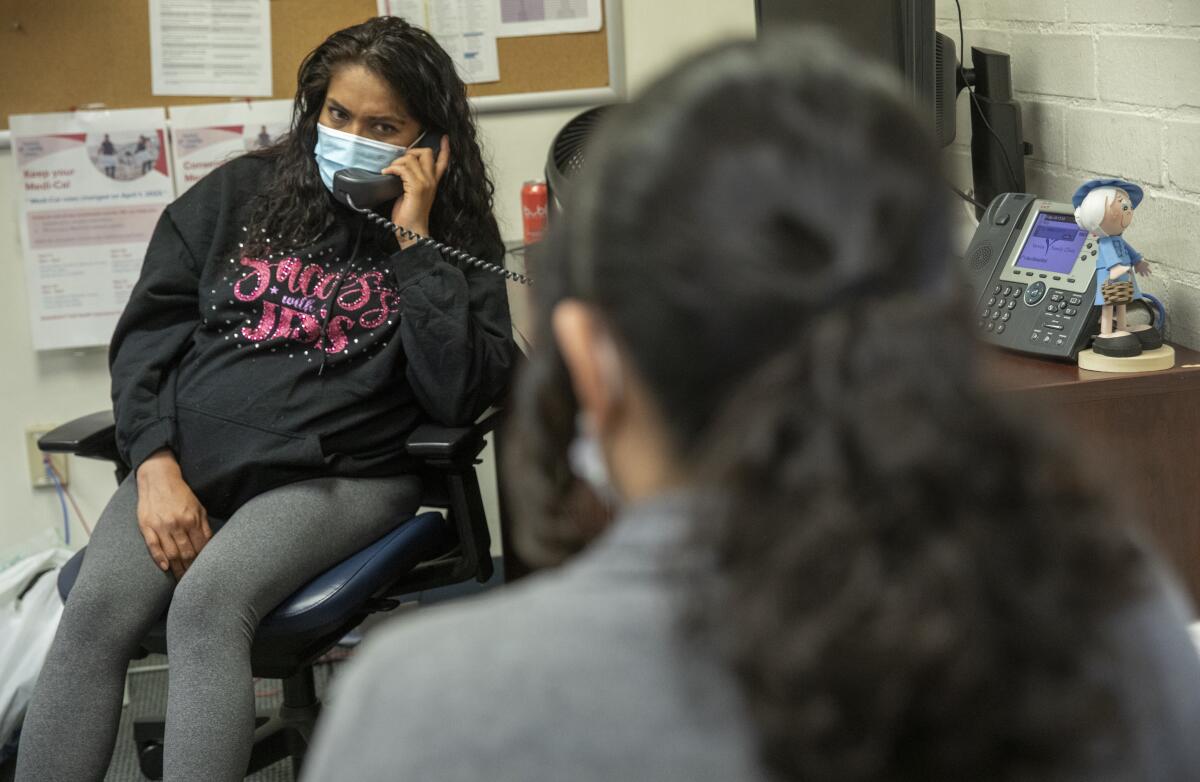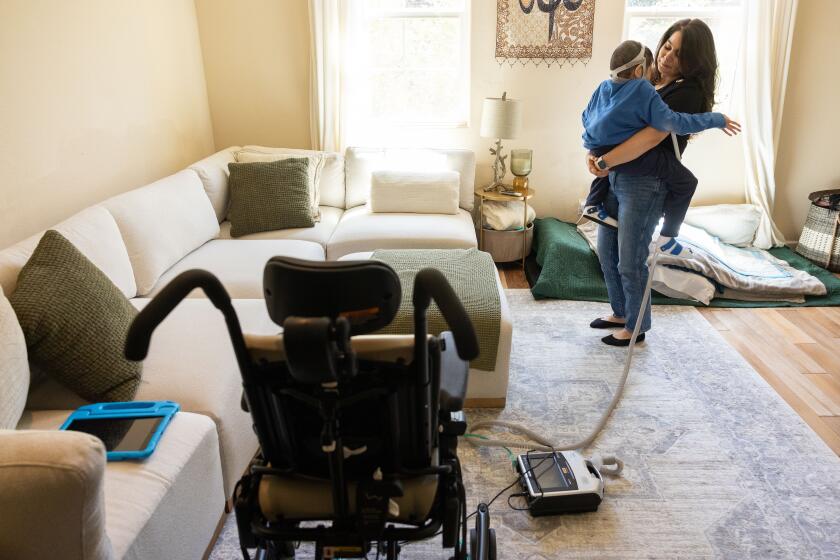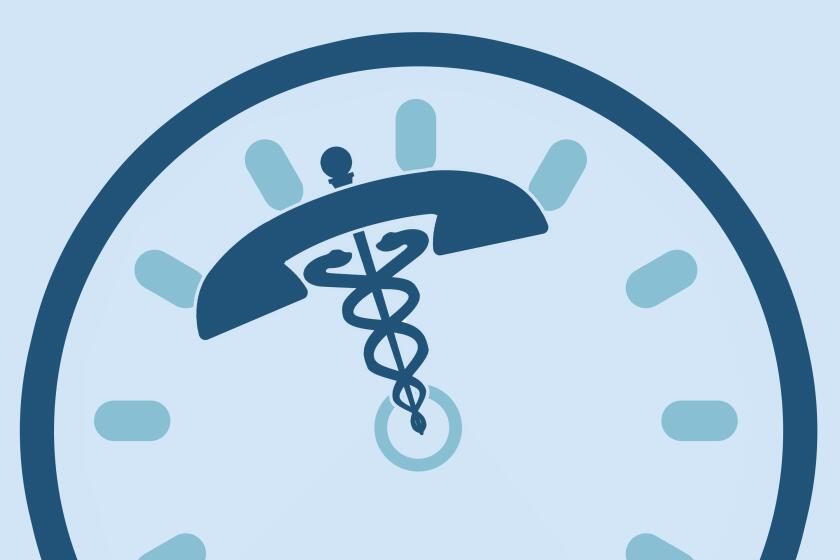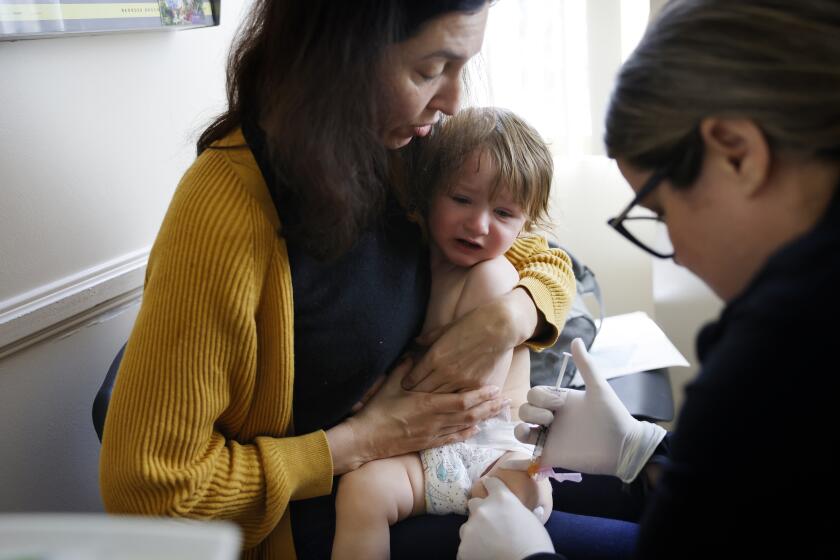Patients phoning for Medi-Cal help are hit with hourlong waits, disconnections, audit finds

- Share via
When Californians phone for help with their Medicaid coverage, they routinely face waits of nearly an hour — and are regularly disconnected without reaching anyone, researchers found in a newly released analysis.
An audit released Wednesday by the Children’s Partnership, an advocacy group focused on child health, found the average wait when researchers phoned in dozens of counties was 55 minutes. More than half of children in California rely on Medi-Cal — the California Medicaid program — for their health insurance coverage, including 1.4 million children 5 and under.
Los Angeles County, which enrolls more than 4 million people in Medi-Cal, had an average wait of just over an hour, according to the analysis.
That is longer than what has been reported by L.A. County itself: Its public social services department said in recent reports that it was averaging a 43-minute wait for Medi-Cal calls at its customer service centers this year and a shorter average — 35 minutes — on a phone line specifically for renewals as of June.
Nick Ippolito, an assistant director in the L.A. County Department of Public Social Services, said the internal wait time figures were based on a much higher volume of calls than the survey. “We were pleased to see that all the calls their secret shoppers made to our call centers were not ended due to high call volume, which indicates that our staff served every customer who called us,” he said.
In some counties including Kern and Fresno, the newly released audit found that average waits for callers stretched longer than an hour and a half. (Fresno County, in turn, pegged its average wait time for calls on all kinds of assistance programs — which share a common line — at 48 minutes.)
Such long waits are “untenable” for many working people, who “may only have 10 minutes during their work day to step away to try to get their Medi-Cal turned back on,” said David Kane, senior attorney with the Western Center on Law and Poverty.
In other cases, “people who don’t have the time make the time,” spending over an hour on hold, and “that comes at a great cost to their jobs, to their families, to their well-being,” Kane said.
Thousands of Californians have been trying to get Medicaid benefits for services to help medically vulnerable people remain at home, but the waitlist is thousands of people long, and the state is opening only 200 new slots a month.
Some callers didn’t even get a chance to wait that long: One out of five phone calls were disconnected after a recorded message saying that call volume was high, according to the analysis conducted for the Children’s Partnership by WestGroup Research. That number was steeper in San Bernardino County, where nearly half of phone calls were cut off because so many people were calling, the audit found.
James LoCurto, director of San Bernardino County’s Transitional Assistance Department, said the agency is “committed to serving our community, providing a great customer experience and continuously striving to improve enrollment and retention rates for the Medi-Cal program.”
In some areas of the state, phone callers who sought help in Spanish or other languages were greeted with long instructions in English before the message switched to their language, which could lead some to hang up before getting help.
And when callers were automatically prompted to leave a voicemail, those messages were rarely returned: Of the 38 messages left by researchers across nine counties, six received a return call in a total of three counties.
Yet in some counties — including some of the biggest in the state — the waits were modest. In San Diego, second only to L.A. County in Medi-Cal enrollees, the average wait for callers was just under a minute, the audit found. One-third of calls there were answered immediately.
“Where somebody lives shouldn’t determine the access that they have when getting their Medi-Cal questions answered,” said Mayra Alvarez, president of the Children’s Partnership. “Everyone should have the same high-quality experience, regardless if you speak English or another language, regardless of where geographically you may live, and regardless of your level of income.”
The marathon waits have alarmed groups that work with California patients as the state has gone back to requiring Medi-Cal recipients to fill out annual paperwork to renew their coverage — a requirement that was suspended earlier in the pandemic to prevent people from losing healthcare amid the threat of COVID.
Only 15% of phone calls seeking psychiatric appointments for Medicaid patients resulted in an appointment in Los Angeles, the lowest percentage out of four cities in a “secret shopper” audit, researchers found.
By May of this year — almost a year after disenrollments began — more than 2 million Californians had been removed from the program, the bulk of them not because they were deemed ineligible but for “procedural reasons” such as failing to return paperwork, according to the nonpartisan health policy organization KFF.
Health advocacy groups have raised concerns that Californians could be losing Medi-Cal unnecessarily because of bureaucratic hangups. In a state survey of people booted for procedural reasons this spring, nearly a third said they didn’t know they would lose Medi-Cal if they failed to fill out the paperwork. Nearly half said that as far as they knew, they hadn’t received a renewal form for their household.
When Medi-Cal recipients run into problems with their paperwork or find their coverage has lapsed, they often turn to the call centers at their counties for help. In the state survey, some of those who had lost Medi-Cal said they had phoned for help but were disconnected, ended up on hold too long, or got no answer.
“For many low-income families, for many immigrant families, the phone is going to be a critical source of connection to services, and so we need to make sure that those phone lines are working for families,” Alvarez said.
Of particular concern, she said, are the 300,000 children who have been removed from the Medi-Cal program since disenrollments began last year. Children who do not attend their well-child visits are more likely to go to the emergency room, skip key vaccinations, and miss out on early interventions for developmental disorders.
“If we want our children to grow up to be healthy, productive adults, we know that healthy childhood development requires these frequent, timely well-child visits and screenings that even a short gap in coverage can disrupt,” Alvarez said.
L.A.’s child-care industry sees big disruptions and uncertainties brought on by a dramatically shifting landscape. Enrollment is still down with no signs of a rebound.
The Children’s Partnership and other advocacy groups have thrown their support behind a state bill, SB 1289, that would require the California Department of Health Care Services to set minimum standards for Medi-Cal call centers.
The bill would also require counties to turn in information about how long callers wait. State Sen. Richard Roth (D-Riverside) said he introduced the bill after hearing about long waits and Californians “being completely unable to get through at all, which is totally unacceptable.”
Roth said counties have had difficulty hiring and retaining staff, especially since the pandemic, but lengthy waits have long been a problem, and “this is a systemic problem that needs to be addressed effectively.”
The state department of healthcare services has estimated that implementing the bill would cost $6.3 million in its first year and $4.3 million annually after that. The legislation has been opposed by the County Welfare Directors Assn. of California unless it is amended to address costs and staffing requirements.
“If counties aren’t funded for staff necessary to meet whatever the standards are, they will be impossible to meet” or will force cutbacks in other operations, said Eileen Cubanski, the association’s interim executive director. The group wants compliance with SB 1289 to be contingent on such funding.
The Fresno County Department of Social Services, for instance, said that as Medi-Cal renewals kicked back into effect, “we all struggled with a limited workforce” and training new staffers. In addition, switching to a new, automated system last fall “required half of our workforce to be unavailable due to training.”
“While the answer rates over this past year have not been ideal, we have significantly improved our service” and are exploring technological tools such as call-back features, the Fresno County agency said.
Roth, asked about the estimated costs of implementing SB 1289, argued such expenses “should already be included in the program costs, as assisting the public with their Medi-Cal applications and renewal questions has long been state law.”
More parents are choosing to delay childhood vaccinations, such as the MMR vaccine. Doctors worry toddlers remain vulnerable as measles spreads.
Times staff writer Jenny Gold is part of The Times’ early childhood education initiative, focusing on the learning and development of California children from birth to age 5. For more information about the initiative and its philanthropic funders, go to latimes.com/earlyed.
More to Read
Sign up for Essential California
The most important California stories and recommendations in your inbox every morning.
You may occasionally receive promotional content from the Los Angeles Times.
















